Guinea pigs, also known as cavy, have become popular pets due to their social, docile, and friendly nature. They come in a wide variety of breeds, colors, and coat types, making them a unique species for genetic research. Guinea pigs have been used extensively in genetics research due to their short generation time and the ease of breeding. In this article, we will provide you with a detailed description of Guinea pigs and genetics.

Genetics of Guinea Pigs
Guinea pigs have 64 chromosomes, which is a relatively high number compared to other domesticated mammals. The genetic makeup of a guinea pig determines its physical appearance, including its coat type, color, and pattern. Guinea pigs have a wide range of coat types such as Abyssinian, Peruvian, Silkie, and Teddy. Each of these coat types is the result of a specific genetic mutation.
Similarly, the color of a guinea pig’s coat is determined by several genes. The Agouti locus is responsible for the distribution of colors in guinea pigs, including black, brown, cream, and white. The Extension locus is responsible for black and red pigmentation in guinea pigs. Other genes that affect the color of a guinea pig’s coat include the Himilayan locus, the Roan locus, and the Self locus.
Breeding Guinea Pigs for Research
Guinea pigs are commonly used in genetic research due to their short generation time, which is around 70-90 days. Guinea pigs can breed throughout the year, and their gestation period is only 68 days. This makes it easier for scientists to study the inheritance patterns of different traits in guinea pigs.
To breed guinea pigs for research, scientists often use inbreeding or selective breeding. Inbreeding involves mating closely related guinea pigs, while selective breeding involves choosing guinea pigs with specific traits to breed. In both cases, scientists can study the inheritance patterns of specific traits and gain insights into the genetics of guinea pigs.
Studying Human Genetics with Guinea Pigs
Guinea pigs have been used to study human genetics due to their similarities in anatomy and physiology. In the 1930s, guinea pigs were used to study the genetics of blood types, which helped scientists better understand the inheritance patterns of human blood types.
More recently, guinea pigs have been used to study the genetics of human diseases such as cystic fibrosis and muscular dystrophy. Scientists have developed guinea pig models for these diseases, which allow them to study the underlying genetic mutations and test potential treatments.

Genetic Disorders in Guinea Pigs
Like all animals, guinea pigs can be affected by genetic disorders. Some of the most common genetic disorders in guinea pigs include dental malocclusions, which is a condition where the teeth do not meet properly, and skin problems, which can be caused by genetic mutations affecting the skin and hair follicles.
In addition, guinea pigs can also be affected by inherited diseases such as polycystic kidney disease, which is a condition where cysts develop in the kidneys and can lead to kidney failure. Guinea pigs can also carry the gene for Scurvy, which can lead to severe vitamin C deficiency.
Importance of Genetic Research in Guinea Pigs
Genetic research in guinea pigs is important for several reasons. First, it allows scientists to better understand the genetics of guinea pigs, which can help breeders produce guinea pigs with specific traits. Second, genetic research in guinea pigs can help scientists better understand the genetics of human diseases and develop new treatments.
Finally, genetic research in guinea pigs can help identify genetic mutations that cause diseases in guinea pigs. This can help breeders avoid breeding guinea pigs with these mutations, which can lead to healthier and happier guinea pig populations.

In conclusion, guinea pigs are a unique species in terms of genetics due to their wide range of coat types, colors, and patterns. They have been extensively used in genetics research due to their short generation time and ease of breeding. Genetic research in guinea pigs is important for improving our understanding of guinea pig genetics, developing treatments for human diseases, and improving the health and well-being of guinea pigs.